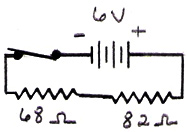A series circuit is formed when the circuit elements are connected together on a single conducting path. If you can trace a path from the positive terminal of the voltage source around the circuit to the negative terminal of the voltage source without lifting your pencil from the paper, the circuit is a series circuit. A break in any part of the single conducting path will stop the current flow in the circuit.
![]() The following video gives a more in-depth analysis of series circuits:
The following video gives a more in-depth analysis of series circuits:
Source: Circuits (part2), Khan Academy, YouTube
Visit Series Circuit, view the animation and write the rules for voltage V, current I, and resistance R in your notes.
A series circuit contains a 6 V battery, a 68 Ω resistor, and an 82 Ω resistor. Determine the current in each resistor?
